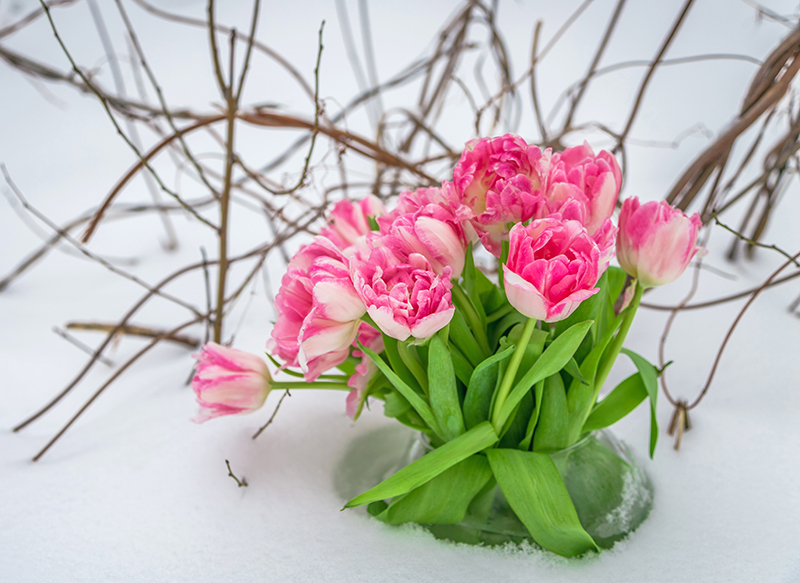The Science Behind Flowers Lifting Mood and Improving Well-Being
Posted on 18/08/2025
The Science Behind Flowers Lifting Mood and Improving Well-Being
Flowers have captivated human hearts for centuries. Their colors, fragrances, and intricate structures aren't just a feast for the eyes--they also offer profound psychological and physiological benefits. If you've ever received a bouquet and felt your spirits soar, you're not alone. There's real science behind why flowers improve well-being and elevate mood. In this comprehensive article, we'll delve into how and why flowers can make you feel better, exploring both the biological and psychological mechanisms at play.

Understanding the Emotional Power of Blooms
Why Are Humans Attracted to Flowers?
From ancient art to modern-day bouquets, flowers consistently hold a privileged place in our lives. Their ubiquity isn't just cultural--they trigger deep-rooted responses, thanks to evolutionary biology. Early humans learned to associate flowers' blooming with upcoming harvests and safe environments. This innate connection primes us to react positively to flowering plants, making their presence naturally uplifting.
- Color Psychology: The vibrant hues of flowers have been shown to stimulate neurotransmitters associated with happiness and relaxation.
- Fragrance Benefits: The scent profiles of certain blooms, such as lavender and jasmine, are proven to reduce stress and promote tranquility.
- Visual Delight: Studies show that exposure to floral arrangements can brighten mood, enhance creativity, and increase feelings of satisfaction.
Scientific Evidence: Flowers and Mental Health
Research on Flowers and Mood Enhancement
A landmark study by Rutgers University found that the presence of flowers increases instant happiness. Participants who received flowers showed a genuine delight and reported long-lasting positive effects. The findings revealed that flowers elicit emotional reactions--including smiles, gratitude, and higher levels of social interaction--across all age groups.
- Participants who received flowers experienced an immediate mood boost.
- Negative moods such as anxiety and depression were significantly reduced when flowers were visible in the environment.
- Flowers in the home and workplace inspired increased enthusiasm, energy, and optimism.
How Flowers Reduce Stress and Anxiety
The soothing effects of flowers are backed by science. A study published in the Journal of Physiological Anthropology demonstrated that individuals working in spaces with fresh flowers experienced lower levels of cortisol, the body's primary stress hormone. Simply looking at or caring for flowers helps the brain switch off its "fight-or-flight" response, fostering a sense of calm and balance.
- Flower Exposure: Even brief interactions with flowers can lower pulse rates and reduce blood pressure.
- Sympathetic Nervous System Benefits: Touching petals and smelling blooms engages the parasympathetic nervous system, triggering relaxation.
The Impact on Productivity and Cognitive Performance
Flowers are more than decorative--they actively enhance cognitive function. Harvard researchers found that participants exposed to flowers in their workspace demonstrated increased creativity, problem-solving skills, and even improved memory retention. The presence of flowering plants has a remarkable capacity to reduce mental fatigue and foster sharper focus.
- Workplaces with flowers report higher rates of employee satisfaction.
- Students surrounded by floral arrangements learn more effectively and perform better on tests.
The Neuroscience of Why Flowers Make Us Happy
Dopamine, Serotonin, and Oxytocin--The "Feel-Good" Chemicals
When we interact with flowers, the brain releases a potent cocktail of neurotransmitters. Dopamine--the pleasure hormone--is stimulated by the surprise and delight of receiving flowers. Serotonin, associated with mood stabilization, surges with exposure to nature's beauty. Lastly, oxytocin--the bonding hormone--may be produced when giving or receiving floral gifts, boosting feelings of social connection.
- Dopamine: Increases feelings of excitement and pleasure when encountering flowers.
- Serotonin: Responsible for elements of contentment and relaxation associated with flowers.
- Oxytocin: Promotes a sense of bonding and love during flower giving and receiving.
The Evolutionary Roots of Our Love for Flowers
Anthropologists suggest that our ancestors' affinity for flowers was advantageous for survival. Flowering plants indicated fertile land and the promise of food, thus humans who paid attention to blooms had a better chance of thriving. Over millennia, this preference became embedded in human psychology, making flowers universally appealing and psychologically rewarding.
How Different Flowers Influence Mood and Well-Being
Popular Flowers and Their Unique Benefits
Every flower species carries unique mood-boosting properties. Choosing the right blooms for your space or as a gift can amplify these psychological effects. Here are some favorite flowers and the science behind their mood-elevating abilities:
- Roses: Known for their association with love, roses can reduce stress and evoke feelings of comfort and harmony.
- Sunflowers: Their bright yellow petals stimulate happiness and optimism, making these flowers ideal for enhancing energy levels.
- Lavender: The soothing aroma of lavender has been shown in multiple studies to lower anxiety and promote restful sleep.
- Orchids: Exotic and elegant, orchids symbolize beauty and are linked to improved concentration and mindfulness.
- Tulips: Associated with renewal and new beginnings, tulips can bring a sense of hope and positivity.
The Role of Color in Flower-Induced Mood Changes
Colors profoundly affect our emotions, and flowers offer a natural kaleidoscope of hues to influence mood:
- Yellow Flowers: Linked to joy, energy, and increased creativity (sunflowers, daffodils).
- Red Flowers: Evoke passion, love, and excitement (roses, geraniums).
- Blue Flowers: Promote relaxation and calm (bluebells, hydrangeas).
- White Flowers: Symbolize peace and purity, offering a grounding effect (lilies, orchids).
Flowers and Physical Health: More Than Just a Mood Booster
Healing Properties Beyond the Mind
The well-being benefits of flowers extend to physical health. Exposure to floral scents and sights can reduce pain perception, promote faster recovery from surgery, and strengthen immune response. Research from Kansas State University concluded that patients with flowers or flowering plants in their hospital rooms needed less pain medication and had lower blood pressure compared to those without.
- Floratherapy: The therapeutic use of flower essences has been shown to help balance emotional disturbances and physical ailments.
- Pain Management: Fragrant blooms like lavender and eucalyptus help distract from discomfort and speed up healing processes.
Boosting Air Quality for Better Health
Many flowering plants are natural air purifiers, removing toxins and improving indoor air quality. Cleaner air leads to better respiratory health and enhanced cognitive function, both critical components of overall well-being.
- Peace Lilies: Remove harmful chemicals from the air, making them perfect for bedrooms and offices.
- Gerbera Daisies: Absorb carbon dioxide and release oxygen at night, improving sleep quality.
Integrating Flowers Into Daily Life for Enhanced Well-Being
Simple Ways to Reap Mood-Boosting Benefits
Bringing flowers into your home or workspace doesn't require a green thumb or a large budget. Here are easy and effective strategies for incorporating flowers into your routine for maximum well-being:
- Fresh Bouquets: Place a small vase of seasonal flowers on your desk or by your bed for a daily happiness boost.
- Grow Your Own: Start a window garden or use potted flowering plants for year-round benefits.
- Floral Mindfulness: Take a few minutes to observe and smell your flowers, practicing mindfulness to heighten the therapeutic effect.
- Flower Gifts: Give flowers to friends and loved ones to spread positivity and reinforce close relationships.
Top Tips for Maximizing Flower Power
- Experiment with different flower varieties to discover what colors and scents resonate most with your mood.
- Regularly change your floral arrangements to maintain a sense of novelty and excitement.
- Pair flowers with other mood-boosting activities like journaling, meditation, or light exercise.
- Consider floral accessories--pressed flowers, dried arrangements, or even floral artwork--to keep the benefits year-round.

The Future of Horticultural Therapy
Flowers as a Tool in Modern Medicine
Healthcare providers are increasingly recognizing the value of flowers for improving mood and well-being. Hospitals, care facilities, and therapeutic programs are integrating horticultural therapy--using flowers and plants to enhance mental health--into their routines. This approach not only supports emotional recovery but also builds life skills and encourages social engagement.
Scientific Advances and Ongoing Research
Ongoing studies continue to uncover the many ways flowers benefit mind and body health. From genetically enhanced blooms with superior scents to virtual floral therapies for patients unable to access gardens, tomorrow's innovations promise even greater benefits and broader accessibility.
Conclusion: Embracing Floral Power for Better Mood and Well-Being
The evidence is clear--flowers lift your mood and improve overall well-being in a multitude of ways. From evolutionary advantages to modern-day therapies, the power of blooms is both timeless and scientifically validated. Whether you're seeking to reduce stress, foster deeper relationships, or simply brighten your day, adding flowers to your life is a beautiful--and effective--solution.
Take a moment to admire, gift, or simply surround yourself with flowers. You'll not only enrich your environment but also nurture your body, mind, and spirit.
Ready to brighten your mood? Add a touch of nature to your space and experience the remarkable science behind flowers and well-being firsthand.
Latest Posts
The Science Behind Flowers Lifting Mood and Improving Well-Being
Simplify Orchid Care with Proven Tips
Keep Your Office Lush with Easy-Care Plants





